Customizing Your iPhone
The iPhone has many settings allowing you to customize how the device works and looks. These settings are all customizable in the Settings app on the Home screen of your iPhone. The iPhone's Settings application offers many ways to enhance your iPhone experience, in addition to those options tied to a particular application. These general settings control everything from screen brightness to sound effects to keyboard tricks. This article covers the remainder of these extra settings and discusses how you can use them in your day-to-day routine. I will start this article by showing you the top five settings people use the most.
Tap the Settings app icon shown in Figure below,
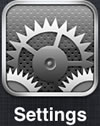
and you'll be presented with the Settings screen, which is a list of preferences for the iPhone and other applications that are installed on it (Figure below). To select an app's settings, tap the name of the app.
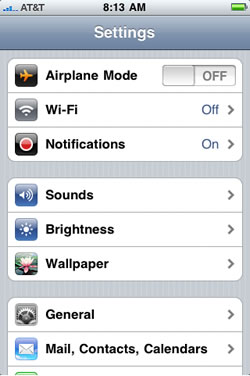
Not all of the settings that are controlled within the Settings app are covered in this article, because they vary by iPhone model and installed applications.
Important Settings
The Settings app lets you really customize your iPhone to its fullest. However, most people won't be messing around with all the advanced settings. Before I launch into explaining all of the general settings, let's go through the top six settings people use the most.
Airplane Mode
This one is for all your frequent fliers and business travelers. Airplane Mode puts your iPhone into a configuration that allows you to use it on a plane without the flight attendant telling you to turn your device off. To enable Airplane Mode, tap the switch to On. You'll notice that an orange airplane icon appears in the upper-left status bar where the signal strength bars and carrier abbreviation usually are.
When Airplane Mode is on, no Bluetooth or Wi-Fi signals emanate from the iPhone. In other words, Airplane Mode disables antennas that can interfere with flight instrumentation. When Airplane Mode is enabled, you are not able to use wireless Bluetooth headsets or use in-flight Internet on your iPhone. You can reenable Wi-Fi when the plane is in flight, even while using Airplane Mode. This allows you to purchase and use in-flight Wi-Fi and even have a video chat with your friends and family back home if you own an iPhone that can run the FaceTime app.
Note that during takeoff and landing, you are instructed to turn off all portable electronics, regardless of whether they are in Airplane Mode or not. After you're back on the ground, turn Airplane Mode off by tap the switch to Off. Since all of your iPhone's wireless transmitters are turned off, turning on Airplane Mode also improves your battery life significantly.
In case you haven't heard, Twitter is the Internet social network and micro-blogging service that allows users to instantly send messages to friends and followers in 140 characters or less. It seems like the whole world is tweeting these days, from your nextdoor neighbor to celebrities and politicians. Twitter is highly integrated into iOS 5. You can tweet directly from Photos, Safari, YouTube, Camera, and Maps, plus many other third-party apps.
Before iOS 5, you had to log into your Twitter account in every app that supported tweeting. With iOS 5, there's just a single login location for Twitter, and that means your Twitter account ID is integrated systemwide for easy tweeting.
To set up your Twitter account, go to Twitter in the Settings app. In the Twitter settings (Figure below), enter your Twitter ID and password, and then tap Sign In. If you don't have a Twitter ID, tap the Create New Account button and set up a new Twitter account right in the Settings screen.
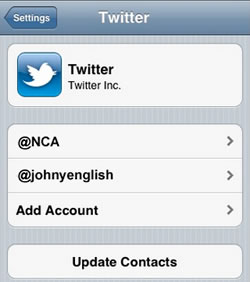
Once you are signed into Twitter, you'll be able to tweet directly from iOS 5's built-in apps like Safari, Maps, YouTube, and more. Also, on the Twitter Settings screen you can tap the Install button to immediately download and install the official Twitter app, which lets you fully interact with Twitter.com and all your friends and followers.
In Twitter Settings, tap your account name for additional settings. These include the ability to let your friends find you on Twitter using your e-mail address and automatically tweeting your location when you post a tweet. Finally, you can tap Update Contacts to add Twitter usernames to the people in your Contacts lists.
Sounds
The Sounds settings enable you to select which ringer and alerts sound effects you hear while interacting with your iPhone (Figure below). These settings are useful when you are using your iPhone in a public place like a library or a coffee shop or attending a meeting.
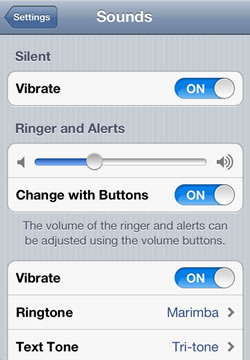
Vibrate: If Vibrate is turned on, your phone will vibrate when receiving a call or other notification. If you've enabled the Mute switch on the side of the phone, the vibration is the only way you'll know that a call is coming in. If the Mute switch is off, your iPhone will both ring and "buzz."
Volume slider: This slider allows you to turn your ringer volume up or down. The ringer volume refers to the level of sound that you hear when someone calls you or initiates a FaceTime call with you.
Change with Buttons: When this is switched to On, you can use the physical volume buttons on the side of your iPhone to adjust the volume level of the ringer and alerts. When set to Off, the volume of the ringer and alerts is separate from the volume of the other sounds (like music playback) on your iPhone.
Ringtone: This allows you to choose your ringtone from one of Apple's built-in ringtones. If you've synced your own ringtones from iTunes, you can also select that ringtone here.
Alerts: By default the iPhone plays a sound effect whenever you send or receive mail, have a calendar alert, lock your iPhone (by pressing the Sleep/Wake button on the top of the iPhone), press a key on the onscreen keyboard, and more. On the Sounds settings screen, you can choose to change any of these sound effects or even disable them entirely. Tap the sound effect you want to change and then select a replacement sound effect from the list of effects or choose None.
Brightness
Choose Settings → Brightness (Figure below) to control your iPhone's screen brightness intensity. The slider at the top of the Settings screen lets you manually set exactly how bright your screen is, from very dim (on the left) to very bright (on the right).
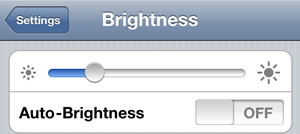
A lot of people who jog or walk at night benefit from turning down the brightness on their iPhone. Your eyes adjust to the darkness, and when you look at your iPhone to read a message or change songs, the screen can temporarily blind you if it's set too bright.
The Auto-Brightness option, beneath the brightness slider, controls another light-level feature. It determines whether your iPhone samples the ambient light when it wakes up as you slide to unlock. When enabled, it adjusts the screen according to the light it senses in the room. If you're in a dim room, it lowers the brightness of the screen. In a brightly lit room, the brightness is enhanced for readability.
Wallpaper
Setting your iPhone's wallpaper is an important and easy way to personalize your iPhone. The Settings → Wallpaper screen allows you to set your system wallpaper from a library of commercial-grade photos that shipped on your iPhone. You can also select wallpaper from any image, such as your personal photos, on your iPhone. Select Wallpaper to see your current lock and Home screen wallpaper settings. To change either wallpaper, tap the lock and Home screen image, and you'll be presented with a list of all the photos on your iPhone. The Wallpaper collection is full of images that came with your iPhone. Below it is a list of all of your photos, both on your iPhone's Camera Roll and in your Photo Stream.
NOTE:
Unlike the images in your Photos library, you cannot move and scale the iPhone's built-in library of Wallpaper pictures. They are sized at 640-by-960 pixels, perfectly matched to your screen.
When you find the image you want to use, move and scale it with your fingers and then tap the Set button. From the pop-up menu, choose to use that image as the lock screen wallpaper, as the Home screen wallpaper, or as both wallpapers.
Location Services
On the iPhone there are dozens of apps that rely on knowing your current location. These include Maps, time zone settings, Weather, photo geolocation, and more. However, in today's privacy-sensitive world, people want to be able to control what apps or processes have access to their current location. That's where Location Services comes in (Figure below).
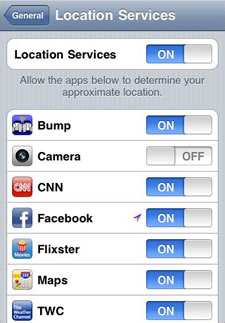
To control location information on your iPhone, navigate to Settings → Location Services. If Location Services is set to On, any apps that can automatically find your location (like the Maps app) are able to do so. Any app that has permission to read your current location shows up in the list. But before any app can access your current location, you must give it approval to do so. A pop-up notification automatically appears when an app requests your current location.
Apps can use your location in any number of ways. The Facebook app, for example, uses your location to tell your friends where you are posting from and the Maps app uses your location in order to help identify where you are on a map.
Location services are very handy. However, today it's easy to get paranoid about people finding you based on your device's location. To turn all location services off, tap the Location Services switch to Off. Alternatively, leave location services on, but disable location services on a per-app basis.
NOTE:
When an app has used your current location in the past 24 hours, you'll see a tiny gray arrowhead icon next to its name in the Location Services settings. When an app is using your current location now, the tiny arrow next to it on this screen is purple. Whenever an app is currently using your location, that tiny arrowhead also appears in the menu bar.
You can also control the amount of access other iOS services have to your location. On the Location Services screen, tap the System Services button, and then toggle on or off services such as location-based iAds, traffic, and diagnostics.
General Settings
Under Settings → General, you'll find that the General settings are the "meat" of settings that have to do with the iPhone itself, like Siri, networking, and security.
"About" Your iPhone
Your iPhone summarizes its capabilities and storage levels, listing the number of songs, videos, photos, and other important information on the Settings → General → About screen. Here, you'll find basic details about the space available and remaining on your iPhone, as well as other details such as the model of your iPhone, the serial number, and more.
At the top of the screen, tap Name to change your iPhone's name. If you scroll all the way down to the bottom of the About screen, you'll see a link labeled Legal. Tap this to jump to an insanely long list of Apple legal notices. It's a boring document to read, but it's an amazingly good place to get some practice flicking your screen. You almost never run out of text to scroll through.
Usage
Usage is another new Settings screen that allows you to see how much storage is being used by each app on your iPhone. View your usage at Settings → General → Usage.
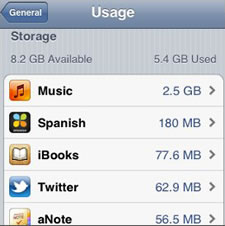
In Figure you can see that the Music app is taking up the most storage space on my iPhone. If I tap Music, I can see documents and data (primarily personal settings) are taking up only 255 KB of storage, while most of the 2.5GB must be the app and its built-in maps. You can delete entire apps (but not the ones that shipped on your iPhone) to free all the space they take up.
Usage is handy if your iPhone is almost full but you want to download a movie at the airport to watch on the plane. You can free up some songs or other content in apps to get enough space to download that movie.
iTunes Wi-Fi Sync
You can now sync your iPhone wirelessly when it's in range of your computer and on the same Wi-Fi network. When you plug your iPhone into a power source, it automatically syncs over the network. You can also manually initiate syncing from your iPhone at any time by going to Settings → General → iTunes Wi-Fi Sync and tapping the Sync Now button.
Network
The settings found on the Settings → General → Network screen duplicate the Wi-Fi settings. They also include a switch to enable, disable, and customize virtual private network (VPN) connections as well as turn your iPhone into a Personal Hotspot.
A VPN is usually used for secure communications over public Internet connections. When this option is enabled, you can configure your VPN account settings with the Network settings screen. Consult your IT department or network provider for details on how to set up your iPhone for a VPN connection.
Personal Hotspot turns your iPhone into a Wi-Fi hotspot anywhere you have a 3G data signal. This feature, which has an extra carrier cost associated with it, means that your cellular data connection can be shared with up to five other users.
Bluetooth
The Bluetooth settings allow you to turn the iPhone's Bluetooth signal on or off. This is also where you'll find a list of Bluetooth-compatible devices that your iPhone is aware of. To pair a Bluetooth device, select it in the list, and then enter the pairing code. For keyboards, a random code is usually generated. For devices such as Bluetooth headsets, look for the code on a label on the headset. Note that some newer Bluetooth devices no longer use pairing codes, show up in your pairing list automatically, and ask whether you want to give the device access. To unpair a Bluetooth device, select it from the list, and choose Forget this Device.
If you aren't using any Bluetooth devices with your iPhone, keep Bluetooth turned off to preserve battery life. Don't forget to switch it back on when you want to use Bluetooth headsets, use external keyboards, or play games between iPhone devices.
Auto-Lock
Use the Settings → General → Auto-Lock screen to determine the period of time after which your iPhone automatically locks. Autolocking is an energy-saving feature. When locked, your screen turns off-although music playback continues-and you must swipe to unlock and return to any previous activities. Choose from 1, 2, 3, 4, or 5 minutes, or choose Never to leave your screen always on. This last option wears down your battery very quickly indeed.
Restrictions
If you share your iPhone with your family or have purchased one for your children, you may want to limit what they can do on it. The Restrictions settings lets you restrict access to Safari, YouTube, the iTunes Store app, the ability to install apps, the Camera and FaceTime apps, and the ability for apps to use location services. In addition, you can also choose what content you want allowed on the iPhone. Settings include restricting In-App purchases and limiting access to movies, music, TV shows, and apps that surpass your chosen ratings. Finally, you can also limit multiplayer gaming in Game Center.
TIP:
Enabling restrictions for YouTube or Facetime is a great way to "remove" factory-installed apps from your iPhone! They're still there; you just won't be able to see their icons on the Home screen!
As you can see, Restrictions is all about protecting your children not only from ageinappropriate music and movies but also from potential outside threats such as strangers calling them on FaceTime or apps that post their current location online. When you enable restrictions, you'll be asked to enter a four-digit passcode. You (or your children) need this passcode to change or disable any restriction you've set up. The only way your kids can get around these restrictions is if they completely restore the iPhone to factory conditions. However, if they do this, they lose all their music and movies on the iPhone.
Date and Time
The settings found on the Settings → General → Date & Time screen allow you to specify how you want your system to handle time. Here, you can choose between a 12-hour (9:30 p.m.) and a 24-hour (21:30) clock, set your time zone, or override the system clock to set a new date and time.
Keyboard
You'll find five very clever and helpful typing settings on the Settings → General → Keyboard settings screen.
Auto-Capitalization: When this feature is set to On, the iPhone is smart about guessing when you're at the start of new sentences. After detecting a period, question mark, or other sentence-ending punctuation, it automatically presses the Shift key for you.
Auto-Correction: When this feature is set to On, the iPhone suggests words to you as you type. Switch it to Off to get rid of those word popups.
Check Spelling: When this is set to On, the iPhone spell-check feature underlines misspelled words in red. Tap the underlined word to see spelling suggestions.
Enable Caps Lock: When selected, Enable Caps Lock treats all taps on the Shift key as the Caps Lock function-setting it either on or off. When it's disabled, you must press the Shift key before each capitalized letter. The Shift key switches itself back off after each use.
"." Shortcut: Enabling the period shortcut feature lets you add a period and then a space to the end of sentences by double-tapping the spacebar.
This is the place where you can set text shortcuts that enable you to type using acronyms that expand to full phrases (in other words, typing ttyl will expand to "talk to you later").
The International Keyboards option on the Keyboard settings screen allows you to set the language for your keyboard. This setting is identical to the one found on the International settings screen we'll discuss now.
International
On the Settings → General → International screen, you'll find all the settings you need if you want your iPhone to operate in a different language. Language: The primary system language determines how all your menus and buttons display. Whenever an iPhone application supports multiple languages, your setting here tells that application which words and phrases to use, internationalizing that application appropriately.
Voice Control: Choose the language you'll be speaking your voice commands in.
Keyboards: The keyboard language sets the default keyboard layout for when you type. If you use a lot of foreign phrases, you may want to switch to an international keyboard for certain tasks. Be aware that the keyboard automatically changes when you set a system language. The rather mysterious number shown on the settings screen indicates the chosen keyboard.
Region Format: The region format switches the standards for how dates, times, and phone numbers display. November 5, 2011, for the U.S. region would display as 5 November 2011 for the U.K. region. Use this setting to augment your language settings with a country norm.
Calendar: This setting changes the calendar format according to which calendar you follow. Select from Gregorian, Japanese, or Buddhist.
